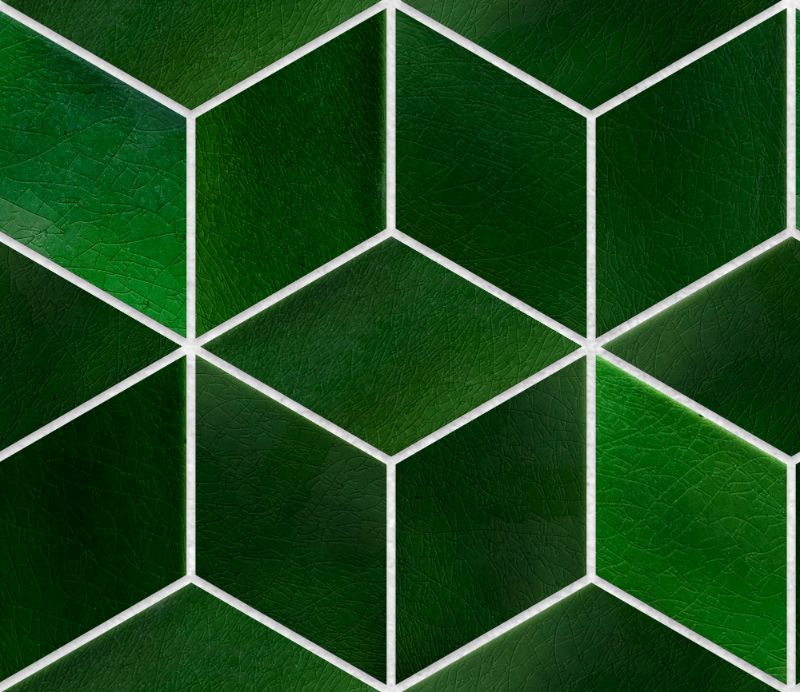Victorian Glazed Cubic
Category
Tile
Download
Edit
A dark green brick with a reflective sheen, glazed bricks are fired once to create the regular brick, to which a ceramic coating is applied and it is fired again, to provide a glossy, decorative finish to regular bricks. They are used on façades, interiors, landscapes and large scale artworks to add vibrancy, colour, brightness and a different, dynamic, unique, standout or highlight colour to a range of settings, often to focus on a key colour or element in the scheme, tease out or reference a specific colour existing in the surrounding context or landscape, or to counterpoint more restrained block patterns and colours. The sapphire and clover greens of this glazed brick create a shimmering effect when lit, with connotations of spring, known for lush, bright, vibrant colours, synonymous with new life, fresh beginnings, or innocence and purity. Commonly found in the closes of tenements and flats, or in the corridors and communal spaces of education and healthcare facilities from the Victorian era (late 19th century), these particular brick tiles were popular for reflecting light into deep-plan spaces, although their history stretches back to at least 12th century Islamic and Asian cultures, where they were used as highly decorative, artistic elements in complex patterns and architectural ornamentation.
Standard bricks are one of the most common materials in architecture and construction. With recorded uses dating back over 9000 years, from its origins as mud and straw adobe bricks, they are popular due to their readily available, easy to gather, raw materials, simplicity of manufacture, low cost, minimal maintenance, basic-skilled assembly and attractive variety of colours, textures and finishes. Modern clay bricks are manufactured by firing clay in moulds, although this method dates back to ancient Egyptian times. They can be cut to standard sizes to form a versatile, durable building product, or specially manufactured to suit a variety of angles, curves and unique shapes for decorative purposes on organic forms. Hard-wearing and with excellent structural and thermal properties, they are a popular, efficient, human-scaled material for paving, load-bearing walls, cladding systems, landscaping and interior decorative walls, while a variety of finishes and palettes within the one product can create rustic, weathered, industrial aesthetics increasingly popular in bespoke, contemporary domestic, hospitality and workplace environments; practical, perfunctory settings; or decorative façades. Preferred for their domestic, human scale, bricks are one of the easiest construction materials to handle and build with when combined and laid with cementitious mortars. They are well suited to domestic, care, primary education and community building types in all climatic settings provided they are manufactured correctly and to the right specifications with respect to their locale.
Brick had been used extensively throughout the Roman Empire thanks to their invention of the mobile kiln, enabling brick manufacture across Rome’s territories, using an increased range of local clay and soil compositions. Before then, brick had generally been limited to hot, dry climates as found in Africa, southern Asian and southern American regions where bricks dried and cured quickly in the heat, especially when composed from mud and straw. Bricks became exceptionally popular in densely populated cities in the 17th century, particularly London, due to their far superior fire retarding properties compared to timber, after particularly serious, destructive urban fires that ripped through older timber building stock. Other cities followed suit during the 18th century industrial revolution, as the vibrant colours of brick stood out against the gloom of polluted, damp, foggy environments, helping to highlight key landmarks around the city, while proving a hardy, enduring, cost effective, simple to construct, reliable, fairly impervious, consistently dimensioned building unit protecting against the menace of damp, pollutant filled air or surrounding ground conditions. Brick was then popularised in northern America and other English and Dutch territories, through early émigrés taking their masonry skills abroad.
The dark, earthy, green colour can be used to create calming feeling spaces, with cool colours such as this often used to suggest rooms are larger, more open or more spacious and less tight or confined than they perhaps are, creating a sense of relaxation, tranquility and safety, while being an excellent pairing for landscape designs which seek to celebrate the natural environment, particularly grass, shrub, plant and tree tones, or bring a sense of the outdoors to interior schemes. Contrasting with earthy orange tones and deep crimsons, reds and purples, this deep green posses a positive yet cool feel. It can be employed on virtually all building types where a human scale, homogenous appearance is desired, be it on large scale construction projects such as workplaces and factory units, or smaller scale works from domestic extensions, gardens and homes to schools and healthcare facilities. Glazed bricks are often used to reflect skies and both natural and artificial lighting, and are particularly popular in contemporary settings from regal kitchen splashbacks and bathroom surrounds, to bold, eye catching retail shop fronts which seek to balance vibrant, modern ideals with period or historically sensitive aesthetics.
A seamless tile texture with victorian glazed arranged in a cubic pattern. Seamless textures can be tiled repeatedly across a surface without visible seams making them useful for architectural drawings and 3D models. This image can be used as a SketchUp texture, Revit material or imported into Photoshop for use in 2D illustrations. A high resolution version of this texture is available, as well as CAD hatches and PBR maps with Architextures Pro.

